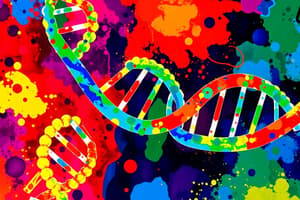Podcast
Questions and Answers
What are the components of a deoxyribonucleotide?
What are the components of a deoxyribonucleotide?
A sugar called deoxyribose, a phosphate group, and a nitrogenous base.
Which of the following nitrogenous bases are purines?
Which of the following nitrogenous bases are purines?
- Adenine (correct)
- Cytosine
- Guanine (correct)
- Thymine
Thymine is unique to RNA.
Thymine is unique to RNA.
False (B)
What type of bonds form the sugar-phosphate backbone of DNA?
What type of bonds form the sugar-phosphate backbone of DNA?
What is the structure proposed by Watson and Crick for DNA?
What is the structure proposed by Watson and Crick for DNA?
What stabilizes the folds of RNA when it is single-stranded?
What stabilizes the folds of RNA when it is single-stranded?
What does the central dogma state?
What does the central dogma state?
What is determined by the specific genes within a genotype that are expressed?
What is determined by the specific genes within a genotype that are expressed?
What enzyme unzips double-stranded DNA during replication?
What enzyme unzips double-stranded DNA during replication?
DNA Polymerase adds nucleotides to the __ end.
DNA Polymerase adds nucleotides to the __ end.
How does replication proceed on the leading and lagging strands?
How does replication proceed on the leading and lagging strands?
Flashcards are hidden until you start studying
Study Notes
DNA Structure
- Deoxyribonucleotides consist of deoxyribose sugar, a phosphate group, and a nitrogenous base
- Purines: adenine (A) and guanine (G)
- Pyrimidines: cytosine (C) and thymine (T)
- Phosphodiester bonds link the phosphate group of one nucleotide to the hydroxyl group of the next nucleotide, forming a sugar-phosphate backbone
- The two strands of DNA are antiparallel, with one strand running 5' to 3' and the other running 3' to 5'
The Double Helix
- Proposed by Watson and Crick
- Sugar-phosphate backbones are on the outside of the double helix
- Purines and pyrimidines form the "rungs" of the DNA helix ladder
- Hydrogen bonds form between complementary nitrogenous bases on the interior of the DNA molecule
RNA Structure
- Ribonucleotides contain ribose sugar instead of deoxyribose
- RNA contains uracil (U) instead of thymine (T)
- RNA is typically single-stranded, but can fold upon itself to form a three-dimensional structure
The Central Dogma
- DNA encodes messenger RNA (mRNA)
- mRNA encodes protein
- The process of DNA replication is key to the central dogma
DNA Replication
- DNA helicase unwinds the double-stranded DNA
- DNA primase synthesizes RNA primers
- DNA polymerase adds nucleotides to the 3' end of the growing strand
- DNA ligase joins fragments of DNA together
- New subunits are always added at the existing 3' end
- Replication begins at the origin of replication, a specific base sequence on the DNA molecule
- Replication proceeds on two strands: the leading strand and the lagging strand
- The leading strand elongates continuously into the replication fork
- The lagging strand elongates discontinuously, away from the replication fork
- RNA primers are laid down first, and then DNA polymerase elongates the new strand
Studying That Suits You
Use AI to generate personalized quizzes and flashcards to suit your learning preferences.





